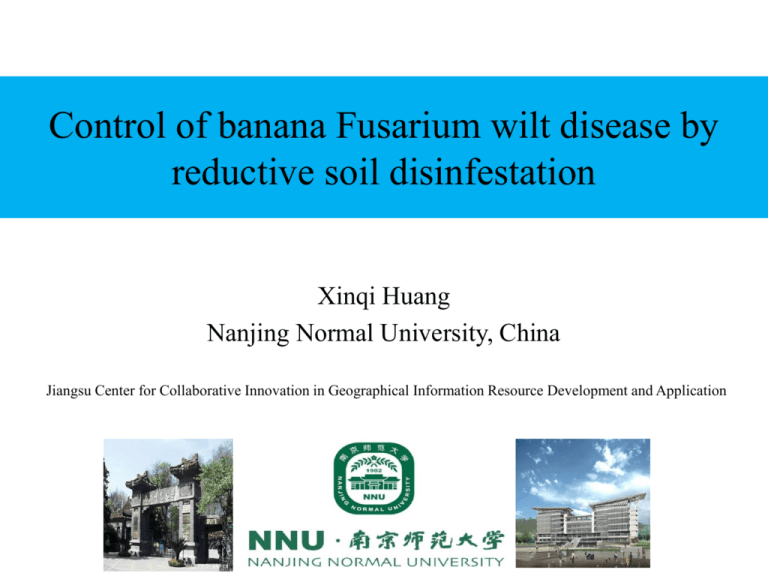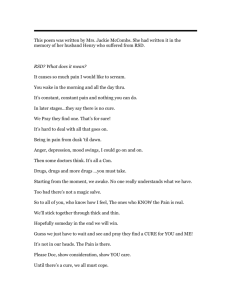Control of banana Fusarium wilt disease by reductive soil
advertisement

Control of banana Fusarium wilt disease by reductive soil disinfestation Xinqi Huang Nanjing Normal University, China Jiangsu Center for Collaborative Innovation in Geographical Information Resource Development and Application Background——Banana Fusarium wilt Background——Banana Fusarium wilt 《Nature》2013 Bananageddon: Millions face hunger as deadly fungus Panama disease decimates global banana crop ——《The independent》2014 Then, some mainstream media in China published the similar reports entitled “Banana AIDS” Background——Current control methods • Disease resistance cultivar • Chemical fumigation • Agronomic management Deep tillage Solarization Crop rotation …… Background——Reductive Soil Disinfestation • Reductive soil disinfestations (RSD), developed separately in Japan (Shinmura 2000) and the Netherlands (Blok et al. 2000) as alternatives to chemical soil disinfestations. • In 2011, RSD was used for the improvements of soil acidification and secondary salinization in our lab. Then, we found the commendable disinfestation effect of RSD. • RSD based upon supplying labile carbon to stimulate microbially-driven anaerobic soil conditions in moist soils covered with polyethylene mulch. The objectives RSD influences on Population of pathogen Microbial community Microbial activity Disease incidence Yield Population of FOC -1 (lg ITS copies g soil) Population of Fusarium oxysporum 7 A a Aa Pre-treatment Tenth day Upper soil after drained Aa Fifth day Fifteenth day Lower soil after drained A B B 6 C RSD cd CK d B b B B b b c cd 5 CK1 CK2 CK3 LS HS HSL PM BA BAL LI Treatments untreated soil (CK1) disturbed soil without flooding (CK2) flooding disturbed soil (CK3) RSD incorporated with rice straw (LS, HS) HS plus lime (HSL) RSD incorporated with pig manure (PM) RSD with bagasse (BA) BA plus lime (BAL) flooding soil with lime (LI) Disinfestation mechanism 6.0 20 6.6 16 organic acids pH pathogen 12 6.4 pH 6.5 6.8 24 Concentration of organic acids (mM) -1 Population of FOC (lg ITS copies g soil) 7.0 8 6.2 4 0 6.0 5.5 -2 0 2 4 6 8 10 12 14 16 The relationships among soil pH, the amount of toxic organic acids and pathogen population Populations of FOC -1 (lg ITS copies g soil) Disinfestation mechanism a 7 a b 6 5 6 Flooding: treated with deionized water Acetic: treated with 30 mM acetic acid Butyric treated with 30 mM butyric acid Ace+But: treated with 15 mM acetic acid and 15 mM butyric acid b 7 Populations of R. solanacearum -1 (lg CFU g soil) bc c a b c d 5 other elements, such as Fe2+, Mn2+, H2S and NH3, might be also involved in the mechanism of RSD. Population of R. solani -1 (lg ITS copies g soil) 4 7 c a 6 b 5 bc c 4 Flooding Acetic Butyric Ace+But Soil microbial community Bacterial Fungi Relative abundance (%) of microbial phyla present in the soils of different treatments. CK, untreated soil. Flooding and RSD, soils treated by flooding and RSD, respectively. Flo-Ban and RSD-Ban, soils of Flooding and RSD treatments after planting banana, respectively. Soil microbial community Bacterial Fungi Ruminococcus Fusarium Coprococcus Podospora Relative abundance (%) of microbial genera present in the soils of different treatments. Soil microbial activity—N transformation Lg gene copies g-1 soil 9.5 9.0 CK Al-RSD-C 8.5 8.0 7.5 7.0 6.5 6.0 5.5 5.0 nifH N fixation AOA AOB nirK Nitrification CK: untreated soil Al-RSD: the soil after RSD treatment taking alfalfa as organic matters nirS Denitrification nosZ Disease incidence of banana Control 2013 field experiment RSD 2013 田间试验 Disease incidence of banana Control 2014 field experiment RSD 2014 田间试验 Disease incidence of banana CK 2014 field experiment RSD 2014 田间试验 Disease incidence of banana Cultivar Disease sensitive Disease resistance Treatments Disease incidence Yield (t/ha) (%) RSD 45.4 31.8 CK 97.8 1.3 RSD 10.1 54.1 CK 32.4 40.7 2014 field experiment Cucumber Fusarium wilt disease RSD Nanjing, Jiangsu Province CK Pepper Fusarium wilt disease RSD RSD Nanjing, Jiangsu Province CK CK Tomato bacterial wilt disease RSD RSD Nanjing, Jiangsu Province CK CK Eustoma Fusarium wilt disease RSD CK Yunnan Province Conclusion • RSD reduced the population of Fusarium oxysporum f. sp. cubense mainly through the production of toxic organic acids. • Cellulose decomposition bacteria (Ruminococcus etc.)and organic acids producers (Coprococcus etc.) were the dominant bacterial genera which might be responsible for the disinfestation effect of RSD taking solid plant residual as organic matters. • The soil N transformation activities were enhanced by RSD. • RSD significantly reduced the disease incidence of banana Fusarium wilt.





